This article is brought to you by FBS.
As we move into 2025, the cryptocurrency market has experienced significant shifts and developments in 2024. With Bitcoin’s impressive growth and the rise of altcoins, the landscape is evolving rapidly. Let’s look closer at the key trends from 2024 and what to expect in 2025.
Key Trends of 2024: Bitcoin and Altcoins
Bitcoin’s Halving Rally
In 2024, Bitcoin’s halving event once again catalyzed a remarkable rally, with BTC prices surging by an impressive 146%. This event, occurring approximately every four years, halves the rewards miners earn for validating transactions. The resulting decrease in new Bitcoin supply often triggers significant market movements due to heightened scarcity.
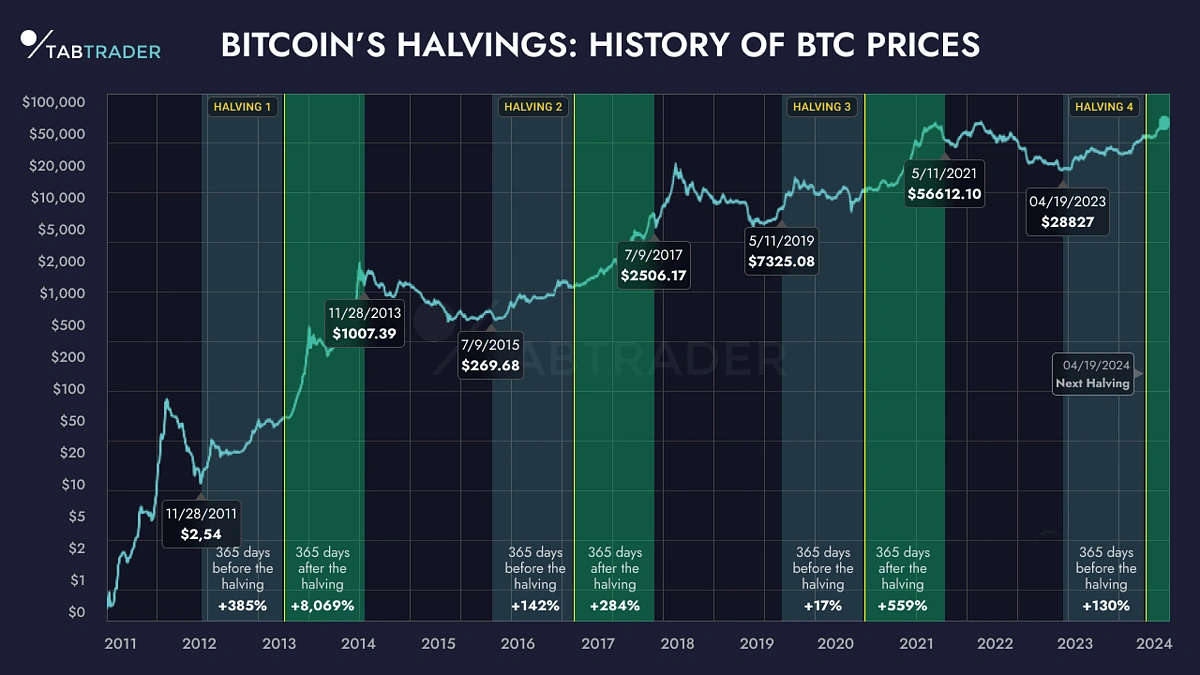
Looking back, Bitcoin's price has historically seen dramatic growth following halvings. For instance, after the 2016 halving, BTC rose from $650 to $20,000 in just over a year. Similarly, the 2020 halving saw Bitcoin climb from around $8,000 to $69,000 at its peak in 2021.
BTC and ETH ETFs Approval
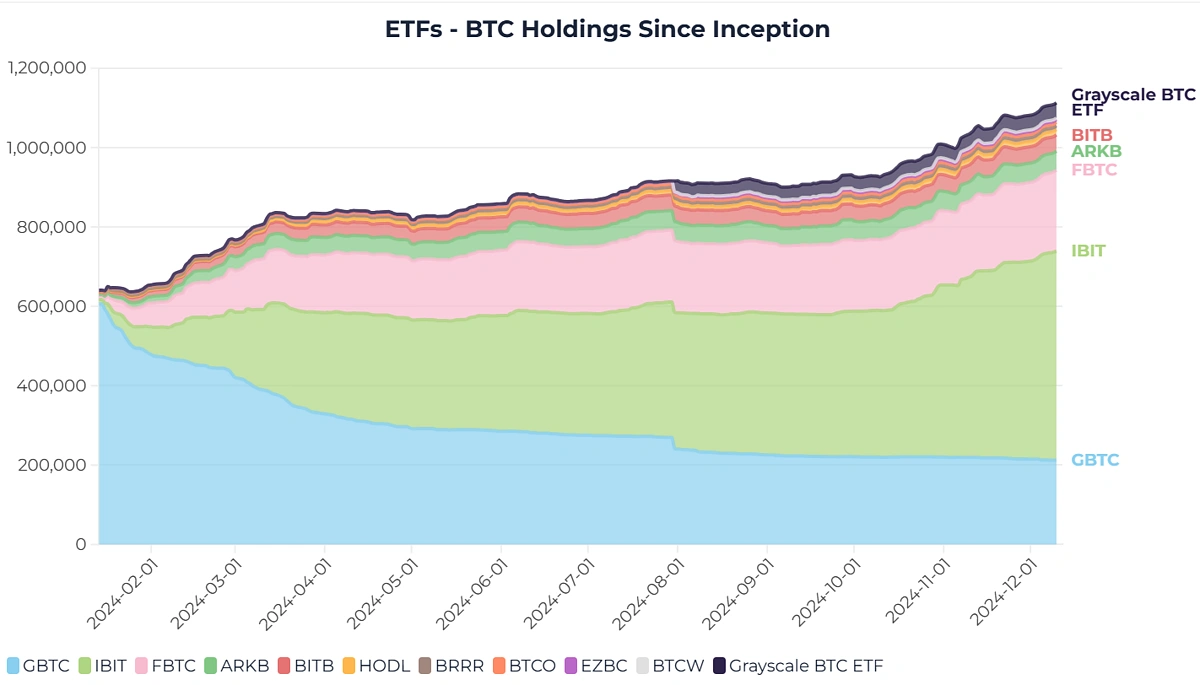
The approval of Bitcoin ETFs and Ethereum ETFs in 2024 marked a transformative moment for the cryptocurrency market, significantly accelerating institutional adoption. The Securities and Exchange Commission's (SEC) long-awaited green light for spot Bitcoin ETFs allowed traditional investors to gain exposure to Bitcoin within a regulated and accessible framework. This approval provided a massive inflow of institutional capital, with Bitcoin’s price seeing a notable boost following the announcement.
Similarly, the approval of Ethereum ETFs elevated Ethereum's status as a serious investment asset. With the SEC approving spot Ether ETFs, it paved the way for traditional financial players to include ETH in their portfolios, strengthening its position as the second-largest cryptocurrency.
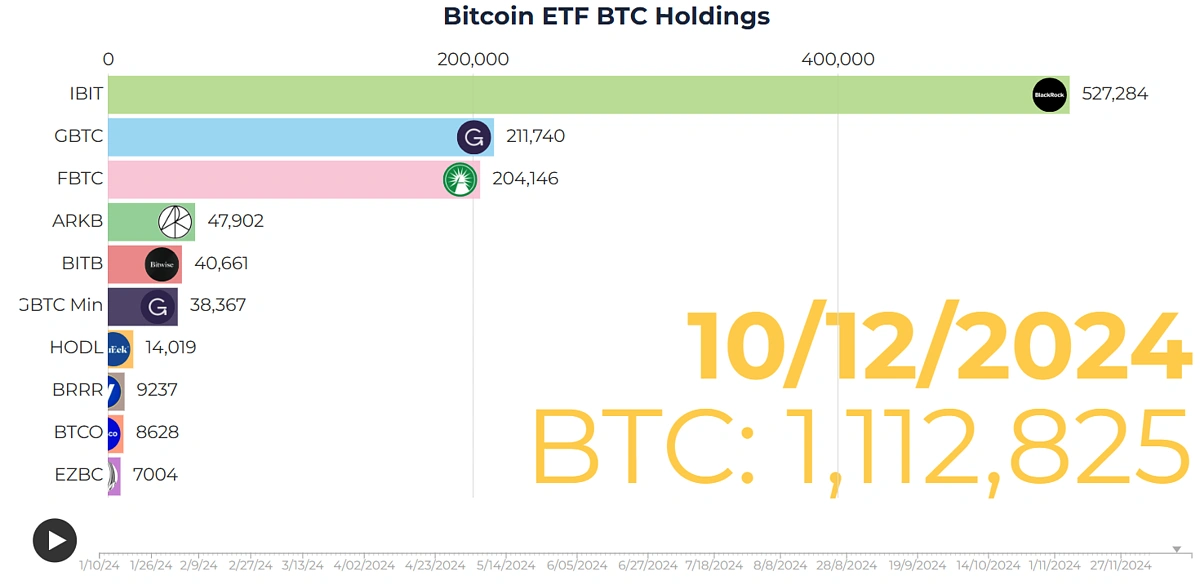
Recent data reveals that institutional investors now own about 20% of all Bitcoin-based exchange-traded funds (ETFs) traded in the US. BlackRock's iShares Bitcoin Trust ETF (IBIT) leads in total BTC held by institutions with over 71,000 BTC, despite its institutional adoption rate being below average at 18.38%. Grayscale's GBTC follows with 44,707.89 BTC held by institutions, representing 20.25% of its shareholders, while Fidelity's FBTC ranks third with 44,623.23 BTC and a 24.14% institutional ownership rate.
ARK 21Shares' ARKB boasts the highest institutional adoption, with 32.8% of its shares owned by asset managers, equivalent to 17,166 BTC. At the other end, Grayscale's Bitcoin Mini Trust has the lowest institutional participation at 1.52%, and the CoinShares Valkyrie ETF (BRRRR) records the smallest absolute holdings of 451.26 BTC among institutions.
Leaked information has revealed that BlackRock, the world's largest asset manager, is in talks to buy a stake in the ‘king’ of bitcoin spot exchange-traded fund (ETF) holders.
The precedent set by these approvals has opened the door for future ETF filings for other cryptocurrencies. There are currently over 10 ETF applications pending review by the SEC for assets like Solana (SOL), XRP, and others, signaling the potential for expanded institutional interest in a broader range of digital assets. These developments could drive further adoption and price momentum across the cryptocurrency market.
Trump Winning the Presidential Election

Donald Trump's 2024 victory has proven to be a game-changer for the cryptocurrency market. Trump’s pro-crypto stance and open discussion of using Bitcoin as a potential tool to repay US debt have significantly bolstered market confidence. This bold vision aligns with his broader agenda of pro-business and deregulation policies, fueling optimism among traders and institutional investors alike.
Following his election win, Bitcoin surged past the $100,000 milestone. Investors anticipate that Trump’s administration will adopt crypto-friendly policies, driving further adoption and fostering innovation in the blockchain space. His victory has also sparked discussions about the potential of integrating cryptocurrencies into broader economic frameworks, creating a favorable environment for digital assets to thrive.
Key Events in 2025 to Watch
Bitcoin as a Tool for Global Economic Policy

One of the most intriguing developments is the discussion of using Bitcoin as a tool for US debt repayment. This bold idea, proposed during Trump’s campaign and gaining traction, has captured global attention. Trump has also been receptive to the proposal for creating a Strategic Bitcoin Reserve, similar to how the Federal Reserve currently held gold reserves. This reserve could serve as an alternative asset to address sovereign debt challenges, showcasing Bitcoin’s potential as a legitimate reserve asset.
The US sovereign debt crisis, fueled by record-high borrowing and persistent fiscal imbalances, has driven policymakers to explore unconventional solutions. Proponents argue that holding Bitcoin as a reserve could hedge against inflation and diversify the nation’s financial toolkit, enabling debt repayments without devaluing the US dollar.
On a national level, following El Salvador’s pioneering move, countries such as Tonga, Paraguay, and Panama are considering adopting Bitcoin as legal tender. Motivated by economic opportunities, financial inclusivity, and remittance efficiencies, these nations seek to capitalize on the cryptocurrency’s potential to modernize their financial systems and attract global investments.
Also, Changpeng Zhao, founder of Binance, has said that China's creation of a strategic bitcoin reserve is inevitable. He noted that although China's policy on cryptocurrencies is unpredictable, the country is able to make quick decisions in this area. Zhao emphasized that if other countries start to form bitcoin reserves, China is likely to follow suit in order to keep up with global financial competition.
Major companies such as Amazon and Microsoft are also fielding enquiries from shareholders to maintain a certain portion of company reserves in bitcoin. While Microsoft shareholders voted against adding Bitcoin to its balance sheet based on the board’s recommendation, its involvement in related discussions signals a shift towards potential bitcoin use cases by large corporations, setting the stage for wider adoption in the coming years.
Approval of Other Cryptocurrency ETFs
Building on the success of Bitcoin and Ethereum ETFs, 2025 could mark a turning point for other cryptocurrency ETFs, including Solana (SOL) and XRP. While the US SEC has previously rejected Solana ETF applications, it continues to review over 10 filings, signaling a sustained interest in expanding crypto-based investment options.
This ongoing scrutiny leaves room for optimism, as market maturity and regulatory clarity could pave the way for approvals, boosting market liquidity and investor confidence.
Widespread Adoption of Real-World Assets (RWA)
The trend of tokenizing real-world assets (RWA) is expected to accelerate in 2025, revolutionizing how traditional finance interacts with blockchain technology. Real estate, commodities, and even fine art are being transformed into blockchain-based tokens, allowing for fractional ownership and broader accessibility.
According to CoinGecko, tokenization could unlock trillions of dollars in previously illiquid assets, making them tradeable in the crypto ecosystem. This shift bridges the gap between traditional and digital finance, offering investors new avenues for diversification while driving innovation across industries.
End of Halving Cycle
Historically, post-halving bitcoin cycles have caused long periods of price appreciation, often lasting up to a year (approximately 365 days). This trend suggests that the first quarter of 2025 will be dominated by residual effects from the 2024 halving, fuelling optimism and driving prices higher. The halving halves the reward for mining, resulting in supply constraints and increased demand, creating a favorable environment for BTC growth. This effect is expected to continue until at least April 2025, providing ample opportunity for investors and traders.
Predictions for 2025: What to Expect in the Crypto Market
Bitcoin Forecast
Building on the momentum from 2024 and the anticipated key events of 2025, Bitcoin’s growth trajectory appears promising. A logarithmic analysis of Bitcoin’s monthly chart reveals its steady movement within an ascending channel. Currently, Bitcoin is approaching a critical axis point within this channel, similar to past bullish cycles.
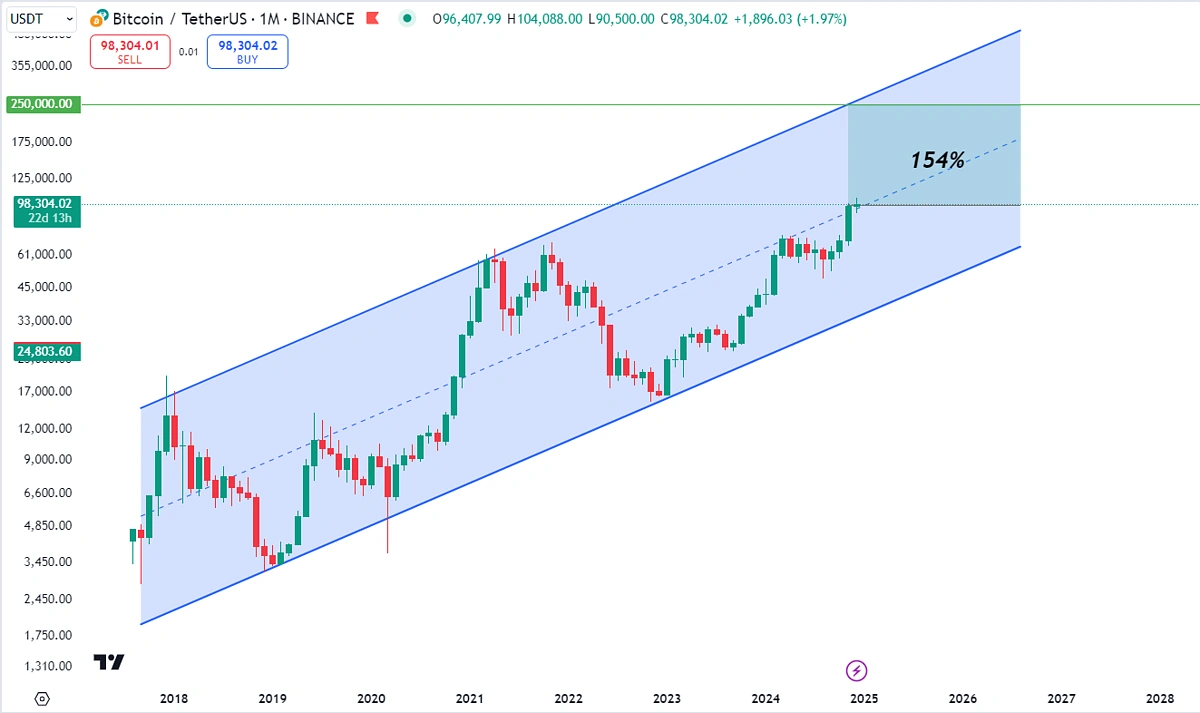
The optimistic projection sees Bitcoin reaching the upper boundary of the channel, reflecting a potential 154% increase in value. This aligns with historical post-halving trends, and under this scenario, Bitcoin could achieve a price of $250,000, further solidifying its position as the leader in the crypto market.
Total Cryptocurrencies Market Cap Forecast
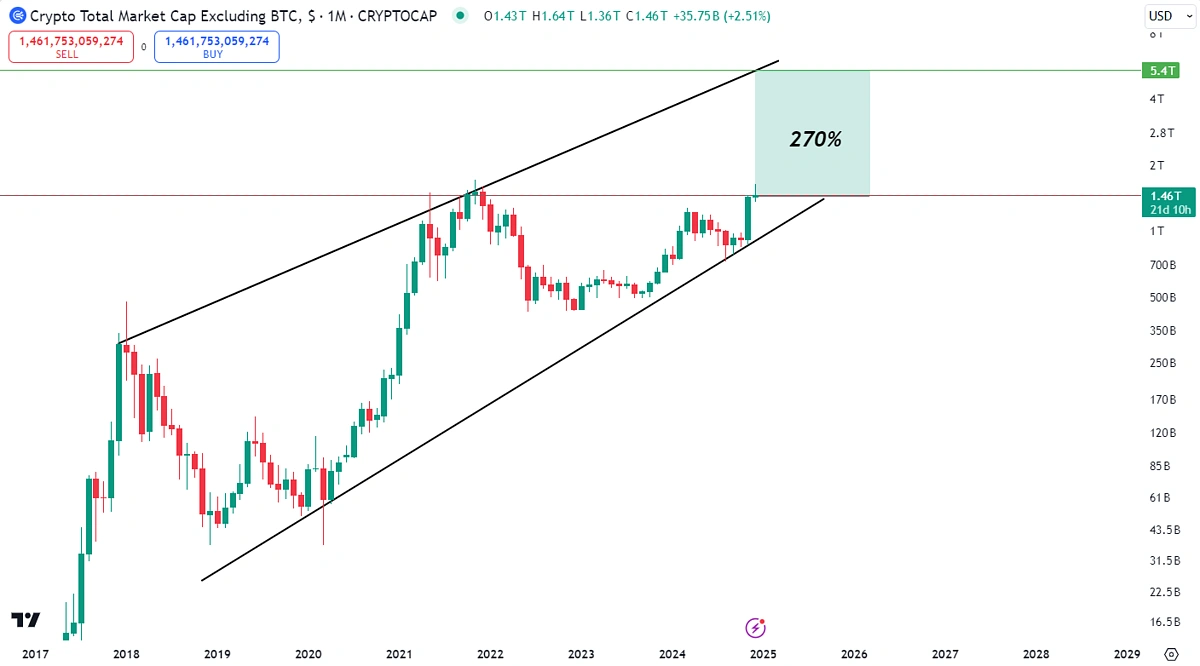
The total crypto market capitalization is showing strong bullish momentum, navigating within a rising wedge pattern. Historically, bull cycle rallies have targeted the upper border of this structure. With the current rebound from the lower trendline, the upper border is estimated to be $3.4 trillion, representing a potential 270% growth.
Total Cryptocurrencies, Excluding Top 10 Market Cap Forecast
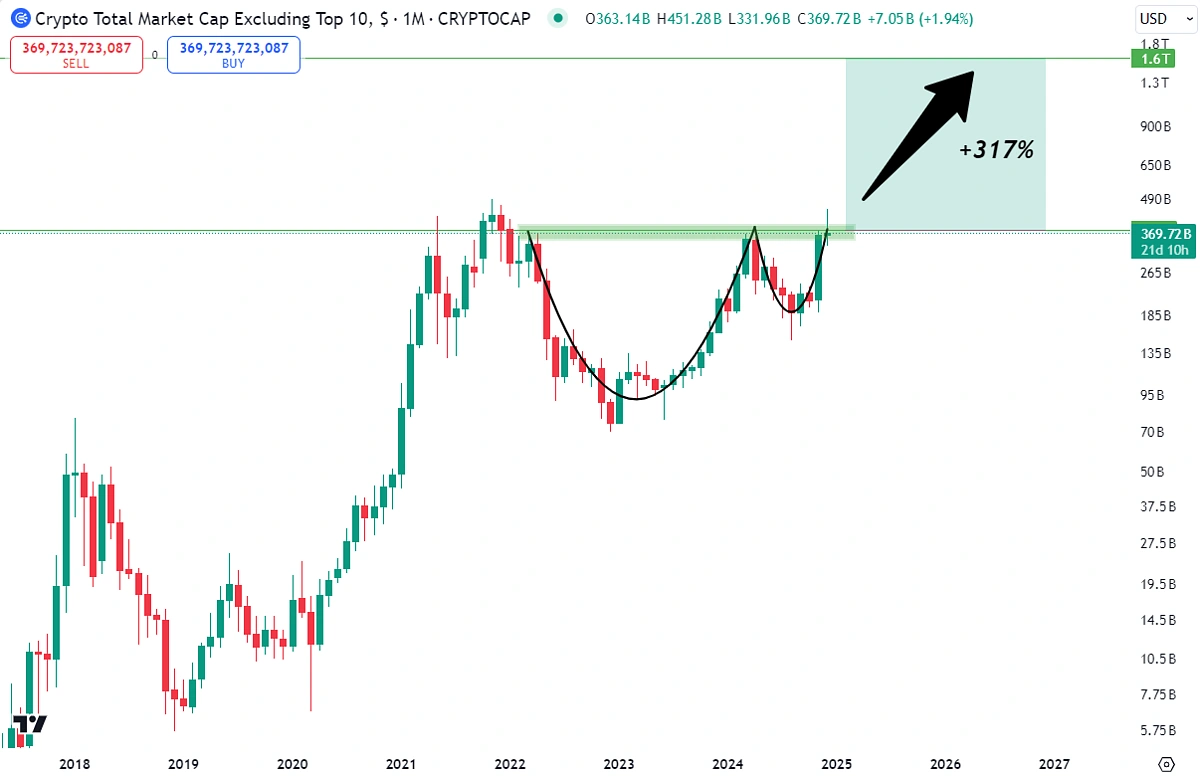
Meanwhile, the total market cap excluding the top 10 cryptocurrencies has formed a classic "cup and handle" pattern on the monthly chart. It is currently testing the $370 billion resistance level. A breakout above this key level could ignite a 317% rally with a potential target of $1.6T, marking the beginning of a robust altcoin season.
Conclusion
The cryptocurrency market is set for remarkable growth in 2025, fueled by 2024's milestones such as Bitcoin's halving rally, ETF approvals, and Trump’s pro-crypto policies. With Bitcoin’s potential integration into economic frameworks, rising altcoin adoption, and the tokenization of real-world assets, the market is poised for innovation and expansion. Despite regulatory challenges, the outlook remains optimistic, with Bitcoin projected to reach new highs and the crypto ecosystem reshaping traditional finance.
This article is only for informational purposes and should not be taken as financial or investment advice. Note that cryptocurrencies are volatile and always do your own research before investing your capital in any protocol or cryptocurrency.
















